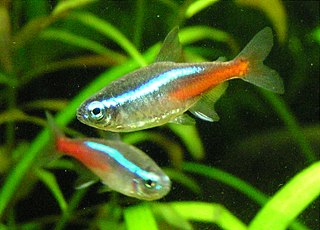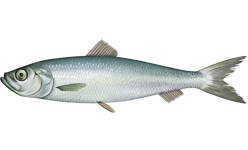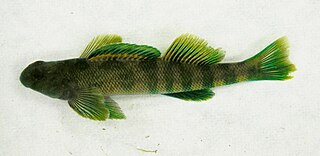
Mackerel is a common name applied to a number of different species of pelagic fish, mostly from the family Scombridae. They are found in both temperate and tropical seas, mostly living along the coast or offshore in the oceanic environment.

Herring are forage fish, mostly belonging to the family of Clupeidae.

Sardine and pilchard are common names for various species of small, oily forage fish in the herring family Clupeidae. The term 'sardine' was first used in English during the early 15th century; a somewhat dubious folk etymology says it comes from the Italian island of Sardinia, around which sardines were once supposedly abundant.

FishBase is a global species database of fish species. It is the largest and most extensively accessed online database on adult finfish on the web. Over time it has "evolved into a dynamic and versatile ecological tool" that is widely cited in scholarly publications.

The ricefishes are a family (Adrianichthyidae) of small ray-finned fish that are found in fresh and brackish waters from India to Japan and out into the Malay Archipelago, most notably Sulawesi. The common name ricefish derives from the fact that some species are found in rice paddies. This family consists of about 37 species in two genera. Several species are rare and threatened, and some 2–4 may already be extinct.

Paracheirodon is a genus of freshwater fish in the family Characidae of the order Characiformes. The type species is P. innesi, the well-known neon tetra, and the Paracheirodon species are among the fishes known as tetras. All species of this genus are native to the Neotropical realm, occurring in the Orinoco and Amazon Basins in northern South America.

Sprat is the common name applied to a group of forage fish belonging to the genus Sprattus in the family Clupeidae. The term also is applied to a number of other small sprat-like forage fish. Like most forage fishes, sprats are highly active, small, oily fish. They travel in large schools with other fish and swim continuously throughout the day.

Arctic cisco, also known as omul, is an anadromous species of freshwater whitefish that inhabits the Arctic parts of Siberia, Alaska and Canada. It has a close freshwater relative in several lakes of Ireland, known as the pollan, alternatively regarded as conspecific with it, or as a distinct species.

Thunnus is a genus of ocean-dwelling, ray-finned bony fish from the mackerel family, Scombridae. More specifically, Thunnus is one of five genera which make up the tribe Thunnini – a tribe that is collectively known as the tunas. Also called the true tunas or real tunas, Thunnus consists of eight species of tuna, divided into two subgenera.

Batasio is a genus of catfish of the family Bagridae. These small fish are found in fast-flowing hillstreams throughout South and mainland Southeast Asia.

Hyalobagrus is a genus of bagrid catfishes found in Southeast Asia.
The egg-carrying buntingi is a species of fish in the family Adrianichthyidae. It is endemic to Lake Poso in Sulawesi, Indonesia.

The Okhotsk Atka mackerel, also known as the Arabesque greenling, is a mackerel-like species in the family Hexagrammidae. It is commonly known as hokke in Japan and imyeonsu in Korean. The primary population of the fish is found off the Sea of Okhotsk.

Fish are very diverse animals and can be categorised in many ways. Although most fish species have probably been discovered and described, about 250 new ones are still discovered every year. According to FishBase about 34,800 species of fish had been described as of February 2022, which is more than the combined total of all other vertebrate species: mammals, amphibians, reptiles and birds.

Several species of fish are claimed to produce hallucinogenic effects when consumed, a condition known as ichthyoallyeinotoxism. For example, Sarpa salpa, a species of sea bream referred to as the "dream-fish", is commonly claimed to be hallucinogenic. These widely distributed coastal fish are normally found in the Mediterranean and around the Iberian Peninsula, west to the Azores and along the west and south coasts of Africa. Occasionally they are found in British or more northerly waters. They may induce hallucinogenic effects similar to LSD if eaten. However, based on the reports of exposure they are more likely to resemble hallucinogenic effects of deliriants than the effects of serotonergic psychedelics such as LSD. In 2006, two men who apparently ate the fish experienced hallucinations lasting for several days. The likelihood of hallucinations depends on the season. Sarpa salpa is known as "the fish that makes dreams" in Arabic.

Clupea is genus of planktivorous bony fish belonging to the family Clupeidae, commonly known as herrings. They are found in the shallow, temperate waters of the North Pacific and the North Atlantic oceans, including the Baltic Sea. Two main species of Clupea are currently recognized: the Atlantic herring and the Pacific herring, which have each been divided into subspecies. Herrings are forage fish moving in vast schools, coming in spring to the shores of Europe and America, where they form important commercial fisheries.

Etheostomatinae is a species-rich subfamily of freshwater ray-finned fish, the members of which are commonly known as the darters. The subfamily is part of the family Percidae which also includes the perches, ruffes and pikeperches. The family is endemic to North America. It consists of three to five different genera and well over 200 species. A common name for these fish in southern Indiana is pollywog.















